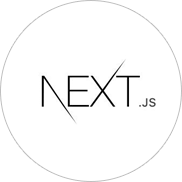https://github.com/ematipico/terraform-nextjs-plugin
A plugin to generate terraform configuration for Nextjs 8 and 9
https://github.com/ematipico/terraform-nextjs-plugin
api-gateway aws cli lambda nextjs plugin serverless terraform terraform-nextjs-plugin
Last synced: 2 months ago
JSON representation
A plugin to generate terraform configuration for Nextjs 8 and 9
- Host: GitHub
- URL: https://github.com/ematipico/terraform-nextjs-plugin
- Owner: ematipico
- License: mit
- Archived: true
- Created: 2019-05-15T14:38:55.000Z (over 6 years ago)
- Default Branch: master
- Last Pushed: 2023-07-20T17:43:12.000Z (over 2 years ago)
- Last Synced: 2025-09-23T23:27:41.364Z (3 months ago)
- Topics: api-gateway, aws, cli, lambda, nextjs, plugin, serverless, terraform, terraform-nextjs-plugin
- Language: JavaScript
- Homepage:
- Size: 13.3 MB
- Stars: 53
- Watchers: 2
- Forks: 5
- Open Issues: 4
-
Metadata Files:
- Readme: README.md
- Changelog: CHANGELOG.md
- License: LICENSE
Awesome Lists containing this project
- awesome-nextjs - Terraform For Next.js - Deploy your application using Terraform (Extensions)
- fucking-awesome-nextjs - Terraform For Next.js - Deploy your application using Terraform (Extensions)
- stars - terraform-nextjs-plugin
README
# Terraform nextjs plugin


A plugin to generate terraform configuration from nextjs pages
[![Build Status][build-status-azure]][build-status-azure-url]
[![Codacy Badge][code-quality]][code-quality-url]
[![npm][npm]][npm-url]
[![Conventional Commits][conventional]][conventional-url]
[![codecov][coverage]][coverage-url]
## The reason
Nextjs supports serverless pages, where it creates files that can be used by some lambdas to render the pages.
Unfortunately, here you are left alone. So here a solution for your troubles.
- [Installation](#installation)
- [Usage](#usage)
- [Via CLI](#via-cli)
- [Via API](#via-api)
- [Configuration](#configuration)
- [Mapping explained](#mapping-explained)
- [Providers](#providers)
- [AWS](#aws)
## Installation
```bash
npm i --save-dev @ematipico/terraform-nextjs-plugin
```
Or
```bash
yarn add --dev @ematipico/terraform-nextjs-plugin
```
**This package requires at least Next v8.**
## Usage
```bash
terranext --provider=AWS
```
This library supports [cosmiconfig](https://github.com/davidtheclark/cosmiconfig): you just need to have a file called `terranextrc` that matches the criteria. This repository has [one](./terranextrc).
### Via CLI
You can use the simple CLI available. At moment you _can't_ pass the `routes` parameter, you will need to use the config object or use the [API](#via-api).
Using the CLI will automatically emit the configuration files.
_**Arguments passed via CLI will *override* the ones that are defined inside the config file**_.
```bash
terranext --provider=AWS --gateway-key=CustomKey --next-dir-app=../../nextjs-project/
```
Or you can use the aliases:
```bash
terranext --provider=AWS -g=CustomKey -p=../../nextjs-project/
```
### Help section
```block
Usage
$ terranext
Options
--gateway-key, -g The API Gateway key of the project. Default is "Terranext"
--next-app-dir, -d The path that Terraform CLI has to follow to reach the nextjs project.
--provider The Cloud provider to use when exporting the configuration
--env A way for passing environment variables to the lambdas
Examples
$ terranext
$ terranext --gateway-key=CustomKey --next-app-dir=../../nextjs-project/
$ terranext --provider=AWS --next-app-dir=../../nextjs-project/
$ terranext -g=CustomKey -d=../../nextjs-project/
$ terranext --env="DEBUG,express:*" --env="API_KEY,1234"
```
### Via API
```js
const generateResources = require("@ematipico/terraform-nextjs-plugin");
const configuration = {
gatewayKey: "AmazingWebsite",
lambdaPath: "../../project/build",
provider: "AWS",
env: [
{
key: "KEY",
value: "2940"
}
]
};
const resources = generateResources(configuration); // inside resources you have the terraform json configuration
generateResources(configuration, true); // it creates two files
```
If the second argument is a boolean and it's `true`, the library will create two files:
- `gateway.terraform.tf.json`
- `lambdas.terraform.tf.json`
Having a suffix with `.tf.` will tell automatically to `terraform` that should be validated and planned.
It will be up to you to consume them in a proper way.
## Configuration
| Name | Type | Default | Description |
| ------------ | ------------------------------ | ------------------| ------------------------------------------------------------------------------------------------------------------------------------------------------------------------------------------------------------------------------------------- |
| `gatewayKey` | `string` | Terranext | A name that will be prefixed to your resources. Usually it's the project name. _Default value: `Terranext`_. |
| `provider` | `string` | Must be provided | The Cloud Provider. Based on the value, a different configuration will be exported. Supported providers: `AWS` |
| `nextAppDir` | `string` | Must be provided | This is the path where your Next.js project is. Usually you will run `terraform` CLI from a different project/folder. So you need to tell `terraform` where this folder is. The library will take care of the rest. _Default value: `"./"`_ |
| `routes` | `Array`, `Mapping` | Optional | This is the structure of the routes that describe your pages. |
| `env` | `Array` | Optional | Environments passed via CLI have to be split using `,`: `--env="KEY,VALUE"`. When using the API, you always have to pass an array of objects `{ key: "MyKeyName", "value": "MyKeyValue" }`. **_Environment variables are applied to all the lambdas_** |
| `nodeVersion` | `10` or `12` | `10` | Runtime to use
### Mapping explained
These mappings are only needed if you have custom routes. If you don't, `routes` is not needed as this library is able to create mappings from the files that Nextjs generates.
Let's say we want to describe the following URLs:
- `/about-us/contacts`
- `/about-us/the-company`
- `/blog/first-blog-post`
- `/blog/second-blog-post`
- `/credits?hideComments`: here, `hideComments` is not mandatory. If it is mandatory, it will be marked `true` in the configuration
```js
const routes = [
{
prefix: "/about-us",
mappings: [
{
route: "/contacts", // the URL
page: "/companyContacts" // the nextjs file, inside pages folder, that is responsible to render this page
},
{
route: "/the-company",
page: "/aboutTheCompany"
}
]
},
{
prefix: "",
mappings: [
{
route: "/blog/:url",
page: "/blogPost"
},
{
route: "/credits",
page: "/credits",
params: {
hideComments: false
}
}
]
}
];
```
## Providers
At the moment the project supports only AWS but it's up to support more providers in the future.
### AWS
Once you generate the resource files, you will need to consume them. Also, you will need to create the following resource:
```hcl
resource "aws_api_gateway_rest_api" "CustomKey" {
name = "WebApi"
description = "Web API"
}
locals {
groupname = "WebApi"
lambda_iam_role = "arn:aws:iam::202020202020:role/lambda_execution_role"
aws_region = "${data.aws_region.current.name}"
}
```
Please check the [integration](/integration/aws/api.tf) testing to see how to consume the configuration.
[build-status-azure]: https://myburning.visualstudio.com/terraform-nextjs-plugin/_apis/build/status/ematipico.terraform-nextjs-plugin?branchName=master
[build-status-azure-url]: https://myburning.visualstudio.com/terraform-nextjs-plugin/_build/latest?definitionId=1&branchName=master
[npm]: https://img.shields.io/npm/v/@ematipico/terraform-nextjs-plugin.svg
[npm-url]: https://www.npmjs.com/package/@ematipico/terraform-nextjs-plugin
[code-quality]: https://api.codacy.com/project/badge/Grade/f77ac77e550449ffb821cd6e7cc4fd72
[code-quality-url]: https://www.codacy.com/app/ematipico/terraform-nextjs-plugin?utm_source=github.com&utm_medium=referral&utm_content=ematipico/terraform-nextjs-plugin&utm_campaign=Badge_Grade
[conventional]: https://img.shields.io/badge/Conventional%20Commits-1.0.0-green.svg
[conventional-url]: https://conventionalcommits.org
[coverage]: https://codecov.io/gh/ematipico/terraform-nextjs-plugin/branch/master/graph/badge.svg
[coverage-url]: https://codecov.io/gh/ematipico/terraform-nextjs-plugin